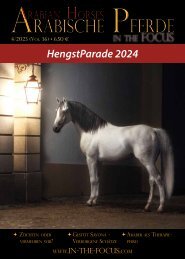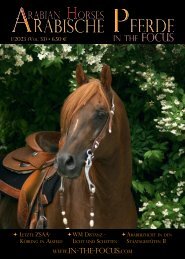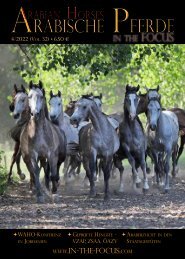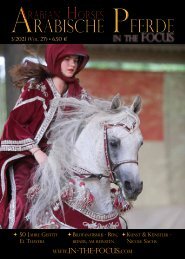Arabische Pferde IN THE FOCUS Nr. 1/2020 (Vol. 21) - Preview
Die Zeitschrift für Freunde und Züchter arabischer Pferde
Die Zeitschrift für Freunde und Züchter arabischer Pferde
Erfolgreiche ePaper selbst erstellen
Machen Sie aus Ihren PDF Publikationen ein blätterbares Flipbook mit unserer einzigartigen Google optimierten e-Paper Software.
The young stallion Gidran XXVII-43 (Kartel)<br />
*2012 (Gidran XXVII / 235 Sigl. Bagd. Gidran-16<br />
(Kelepce)) carries the blood of Siglavy Bagdady<br />
in his dam's line. -<br />
Der junge Hengst Gidran XXVII-43 (Kartel)<br />
*2012 führt das Blut von Siglavy Bagdady<br />
über seine Mutterlinie.<br />
all photos: G. Waiditschka<br />
Zucht<br />
The Gidran is the classical<br />
Anglo-Arabian of Hungary,<br />
and much admired for its<br />
characteristics, such as his<br />
suitability for jumping and<br />
eventing. It is also a rare<br />
breed, of which there are<br />
only a couple of hundred<br />
broodmares left. About a<br />
third of them live today at<br />
the Hungarian State Stud<br />
Mezöhegyes.<br />
Gidran -<br />
The “Anglo-Arabian”<br />
The Gidran breed is a rare breed with a<br />
200-year-old history, starting during<br />
the K.K. Monarchy. It was in 1816, when<br />
Baron von Fechtig bought several Arabian<br />
horses in the Near East and brought them<br />
to Europe. Among them was the 5-year-old<br />
chestnut stallion Siglavy Gidran whom he<br />
sold to Bábolna for 2800 fl. In Bábolna, he was<br />
used between 1818 and 1824, leaving more<br />
than 100 offspring. One of these was Gidran II<br />
(Sigl. Gidran db / Arrogante (Spanish)) *1818.<br />
When he was transferred to Mezöhegyes, he<br />
became the foundation stallion of the Gidran<br />
breed. Every Gidrán in existence today can be<br />
traced to this one stallion.<br />
from Hungary<br />
A Typical Austro-Hungarian Breed<br />
In the beginning, the Gidrans were Arabian<br />
crossbreds, similar to the Shagya-Arabians<br />
(at the time called "Araberrasse"), even<br />
though they had different damlines. The official<br />
foundation of the breed is marked in<br />
1855. At that time, the dams of the Gidran<br />
chief sires were 33% Arabian, 22% Transylvanian,<br />
16% Spanish, 16% Nonius, 6% Native<br />
Hungarian, and 6% Gidran mares. All in<br />
all, the breed originally had 15 female ancestors,<br />
but some damlines had been lost in<br />
the meantime. Until then, the Gidrans were<br />
used as light cavalry mounts. From 1862,<br />
several English Thoroughbred stallions were<br />
used and the breed changed into a Hungarian<br />
Anglo-Arab. The intention was to improve<br />
the conformation and performance<br />
of these horses, and to avoid inbreeding.<br />
The daughters of these stallions were again<br />
bred to pure Gidran stallions after 1-2 generations.<br />
The sons of the thoroughbred stallions<br />
(with a few exceptions) were excluded<br />
from breeding. In 1885, the Gidran stock was<br />
named as an independent breed by the Austrian<br />
Ministry of War (Kriegsministerium)<br />
and from then on was bred mainly at Mezöhegyes,<br />
and as such it is considered a "stud<br />
breed". All members of the breed had to be<br />
chestnut.<br />
26<br />
© ARABISCHE PFERDE - <strong>IN</strong> <strong>THE</strong> <strong>FOCUS</strong> 1/<strong>2020</strong>
















